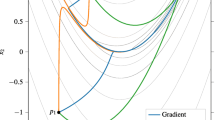Abstract
The generalized least squares (GLS) method uses both data and prior information to solve for a best-fitting set of model parameters. We review the method and present simplified derivations of its essential formulas. Concepts of resolution and covariance—essential in all of inverse theory—are applicable to GLS, but their meaning, and especially that of resolution, must be carefully interpreted. We introduce derivations that show that the quantity being resolved is the deviation of the solution from the prior model and that the covariance of the model depends on both the uncertainty in the data and the uncertainty in the prior information. On face value, the GLS formulas for resolution and covariance seem to require matrix inverses that may be difficult to calculate for the very large (but often sparse) linear systems encountered in practical inverse problems. We demonstrate how to organize the computations in an efficient manner and present MATLAB code that implements them. Finally, we formulate the well-understood problem of interpolating data with minimum curvature splines as an inverse problem and use it to illustrate the GLS method.



Similar content being viewed by others
References
Abers G (1994) Three-dimensional inversion of regional P and S arrival times in the East Aleutians and sources of subduction zone gravity highs. J Geophys Res 99:4395–4412
Backus GE, Gilbert JF (1968) The resolving power of gross earth data. Geophys J R Astron Soc 16:169–205
Backus GE, Gilbert JF (1970) Uniqueness in the inversion of gross Earth data. Philos Trans R Soc Lond Ser A 266:123–192
Boyd S, Vandenberghe L (2004) Convex optimization. Cambridge University Press, Cambridge
Bracewell R (1986) The Fourier transform and its applications. McGraw-Hill, New York
Briggs IC (1974) Machine contouring using minimum curvature. Geophysics 39:39–48
Candes EJ, Wakin MB, Boyd SP (2008) Enhancing sparsity by reweighted L1 minimization. J Fourier Anal Appl 14:877–905
Chen S, Donoho D, Saunders M (1998) Atomic decomposition by basis pursuit. SIAM J Sci Comput 20:33–61
Claerbout J (1976) Fundamentals of geophysical data processing. McGraw-Hill, New York, p 274
Cuer M, Bayer R (1980) FORTRAN routines for linear inverse problems. Geophysics 45:1706–1719
Evans EL, Meade BJ (2012) Geodetic imaging of coseismic slip and postseismic afterslip: sparsity promoting methods applied to the great Tohoku earthquake. Geophys Res Lett 39. doi:10.1029/2012GL051990
Figueiredo M, Bioucas-Dias JM, Nowak RD (2007) Majorization–minimization algorithms for wavelet-based image restoration. IEEE Trans Image Process 16:2980–2991
Friedel S (2003) Resolution, stability and efficiency of resistivity tomography estimated from a generalized inverse approach. Geophys J Int 153:305–316
Gholami A, Siahkoohi H (2010) Regularization of linear and non-linear geophysical ill-posed problems with joint sparsity constraints. Geophys J Int 180:871–882
Gunther T (2004), Inversion methods and resolution analysis for the 2D/3D reconstruction of resistivity structures from DC measurements PhD thesis, Technische Universitat Bergakademie Freiberg
Hetenyi M (1979) Beams on elastic foundation. University of Michigan Press, Ann Arbor, p 245
Householder AS (1958) Unitary triangularization of a nonsymmetric matrix. J ACM 5:339–342
Kalscheuer T (2008) Improvement and assessment of two-dimensional resistivity models derived from radiomagnetotelluric and direct-current resistivity data PhD thesis, Uppsala University, 2008
Kalscheuer T, de los Ángeles García Juanatey M, Meqbel N, Pedersen LB (2010) Non-linear model error and resolution properties from two-dimensional single and joint inversions of direct current resistivity and radiomagnetotelluric data. Geophys J Int 182:1174–1188
Lawson C, Hanson R (1974) Solving least squares problems. Prentice-Hall, Englewood Cliffs
Legendre AM (1805) Nouvelles méthodes pour la détermination des orbites des comètes. [New Methods for the Determination of the Orbits of Comets]. (in French), Paris: F. Didot
Lerner-Lam A, Jordan TH (1987) How thick are the continents? J Geophys Res 92:14007–14026
Menke W (1984) Geophysical data analysis: discrete inverse theory, 1st edn. Academic Press Inc, New York
Menke W (2005) Case studies of seismic tomography and earthquake location in a regional context. In: Levander A, Nolet G (eds) Seismic earth: array analysis of broadband seismograms. Geophysical Monograph Series 157. American Geophysical Union, pp 7–36
Menke W (2012) Geophysical data analysis: discrete inverse theory, MATLAB edn. Elsevier Inc, New York
Menke W, Abbott D (1989) Geophysical theory. Columbia University Press, Columbia
Menke W, Levin VV (2003) The cross-convolution method for interpreting SKS splitting observations, with application to one and two layer anisotropic earth models. Geophys J Int 154:379–392
Menke W, Menke J (2011) Environmental data analysis with MATLAB. Elsevier Inc, New York
Press W, Teukolsky S, Vetterling WT, Flannery BP (2007) Numerical recipies, 3rd edn. Cambridge University Press, Cambridge
Rektorys K (1969) Survey of applicable mathematics. M.I.T Press, Cambridge
Schoenberg IJ (1946) Contributions to the problem of approximation of equidistant data by analytic functions. Quart Appl Math 4:45–99, 112–141
Smith SW (1997) The scientist and engineer’s guide to digital signal processing. (eBook), DSPguide.com
Smith W, Wessel P (1990) Gridding with continuous curvature splines in tension. Geophysics 55:293–305
Tarantola A, Valette B (1982a) Generalized non-linear inverse problems solved using the least squares criterion. Rev Geophys Space Phys 20:219–232
Tarantola A, Valette B (1982b) Inverse problems = quest for information. J Geophys 50:159–170
Wiggins RA (1972) The general linear inverse problem: Implication of surface waves and free oscillations for Earth structure. Rev Geophys Space Phys 10:251–285
Yao Z, Roberts R, Tryggvason A (1999) Calculating resolution and covariance matrices for seismic tomography with the LSQR method. Geophys J Int 138:886–894
Acknowledgments
This research was supported by the US National Science Foundation under grants OCE-0426369 and EAR 11-47742.
Author information
Authors and Affiliations
Corresponding author
Electronic supplementary material
Below is the link to the electronic supplementary material.
Rights and permissions
About this article
Cite this article
Menke, W. Review of the Generalized Least Squares Method. Surv Geophys 36, 1–25 (2015). https://doi.org/10.1007/s10712-014-9303-1
Received:
Accepted:
Published:
Issue Date:
DOI: https://doi.org/10.1007/s10712-014-9303-1




